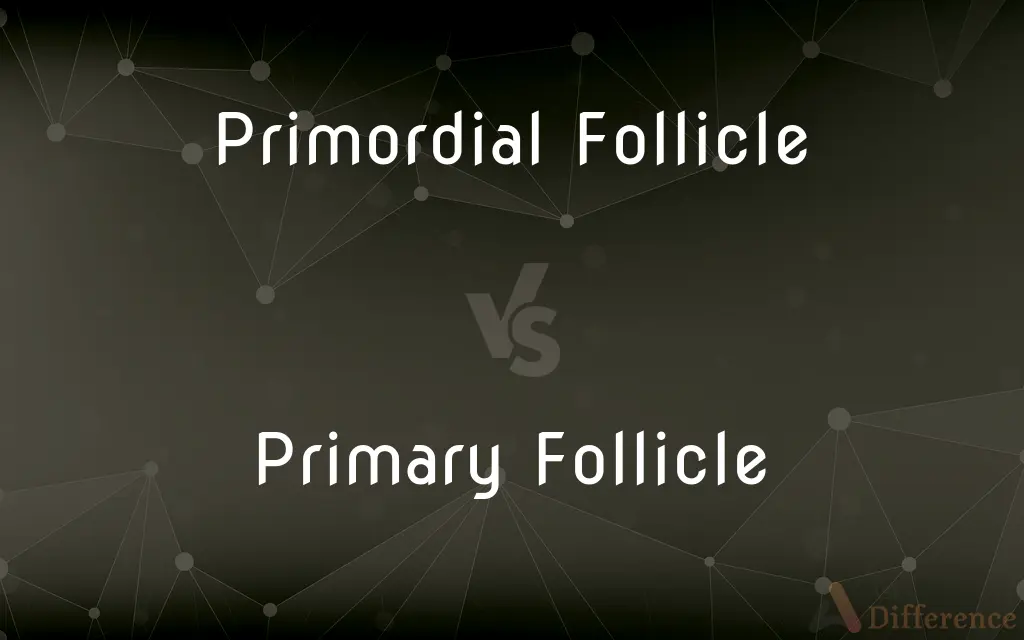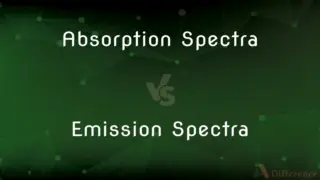Primordial Follicle vs. Primary Follicle — What's the Difference?
By Tayyaba Rehman — Published on December 21, 2023
Primordial Follicles are immature, containing an oocyte surrounded by flat granulosa cells. Primary Follicles are slightly developed, with an enlarged oocyte and a single layer of cuboidal granulosa cells.

Difference Between Primordial Follicle and Primary Follicle
Table of Contents
ADVERTISEMENT
Key Differences
Primordial Follicles represent the initial stage of follicular development in the ovaries. These follicles are formed during fetal life, and they consist of an immature oocyte surrounded by a layer of flat granulosa cells. Their primary purpose is to serve as a reserve for potential oocyte development throughout a female's reproductive years.
On the other hand, Primary Follicles are a more developed stage, emerging from the maturation of Primordial Follicles. At this phase, the oocyte is surrounded by a layer of cuboidal granulosa cells. This transformation indicates the start of an active developmental pathway that might eventually lead to ovulation if the follicle continues its maturation process.
The transition from Primordial Follicle to Primary Follicle is a crucial step in the ovarian cycle. As Primordial Follicles get activated, the granulosa cells surrounding the oocyte change from a flat to a more cuboidal shape, marking the evolution to a Primary Follicle. This change is a clear indication of the commencement of the oocyte's journey towards possible fertilization.
While both Primordial and Primary Follicles are essential components of female reproductive biology, they denote different stages of follicular development. The former remains quiescent until activated, and the latter represents an active stage of growth, preparing for subsequent phases of development.
Comparison Chart
Stage of Development
Earliest stage
Developed from primordial stage
ADVERTISEMENT
Granulosa Cell Shape
Flat
Cuboidal
Origin
Formed during fetal life
Evolves from primordial follicle
Duration of Existence
Exists from birth till menopause
Exists temporarily during menstrual cycle
Potential for Ovulation
Remains dormant
Has potential if it continues maturation
Compare with Definitions
Primordial Follicle
Formed during fetal life and serves as an oocyte reserve.
Primordial Follicles ensure a female has potential oocytes for future reproduction.
Primary Follicle
Emerges from the maturation of a primordial follicle.
As granulosa cells change, a Primordial Follicle transforms into a Primary Follicle.
Primordial Follicle
Contains an immature oocyte surrounded by flat granulosa cells.
A Primordial Follicle stays dormant until activation signals come into play.
Primary Follicle
It's an interim phase in the potential path to ovulation.
If conditions are right, a Primary Follicle might mature further in the ovarian cycle.
Primordial Follicle
Earliest stage of follicular development in ovaries.
Females are born with a finite number of Primordial Follicles.
Primary Follicle
The oocyte is surrounded by cuboidal granulosa cells.
In a Primary Follicle, the distinct cuboidal granulosa cells indicate growth.
Primordial Follicle
Activation initiates its transition to the next follicular stage.
Once a Primordial Follicle activates, it embarks on a developmental journey.
Primary Follicle
A more advanced stage of ovarian follicular development.
The Primary Follicle represents an active phase in the ovarian cycle.
Primordial Follicle
Represents a quiescent state in the ovarian reserve.
Most Primordial Follicles remain inactive for years before any possible activation.
Primary Follicle
Indicates the commencement of the oocyte's maturation journey.
A Primary Follicle has potential to progress to later stages leading to ovulation.
Common Curiosities
How do you distinguish a Primary Follicle from a Primordial Follicle based on cell type?
A Primary Follicle has cuboidal granulosa cells, while a Primordial Follicle has flat ones.
From which follicle does the Primary Follicle develop?
The Primary Follicle develops from the Primordial Follicle.
When are Primordial Follicles formed in females?
Primordial Follicles are formed during fetal life.
Does every Primordial Follicle become a Primary Follicle?
No, not every Primordial Follicle activates and progresses to the Primary stage.
What represents the initial stage of follicular development?
The Primordial Follicle represents this initial stage.
What indicates the activation of a Primordial Follicle?
The change of granulosa cells from flat to cuboidal indicates the activation.
Is the Primary Follicle a final stage in follicular development?
No, the Primary Follicle is an intermediate stage with further potential maturation phases.
What type of granulosa cells surround the oocyte in a Primordial Follicle?
In a Primordial Follicle, the oocyte is surrounded by flat granulosa cells.
Which follicle remains dormant for a potentially long duration?
The Primordial Follicle can remain dormant for long periods.
In which follicular stage is the oocyte's maturation journey initiated?
It's initiated in the Primary Follicle stage.
Share Your Discovery

Previous Comparison
Absorption Spectra vs. Emission Spectra
Next Comparison
Monocot Embryo vs. Dicot EmbryoAuthor Spotlight
Written by
Tayyaba RehmanTayyaba Rehman is a distinguished writer, currently serving as a primary contributor to askdifference.com. As a researcher in semantics and etymology, Tayyaba's passion for the complexity of languages and their distinctions has found a perfect home on the platform. Tayyaba delves into the intricacies of language, distinguishing between commonly confused words and phrases, thereby providing clarity for readers worldwide.













































